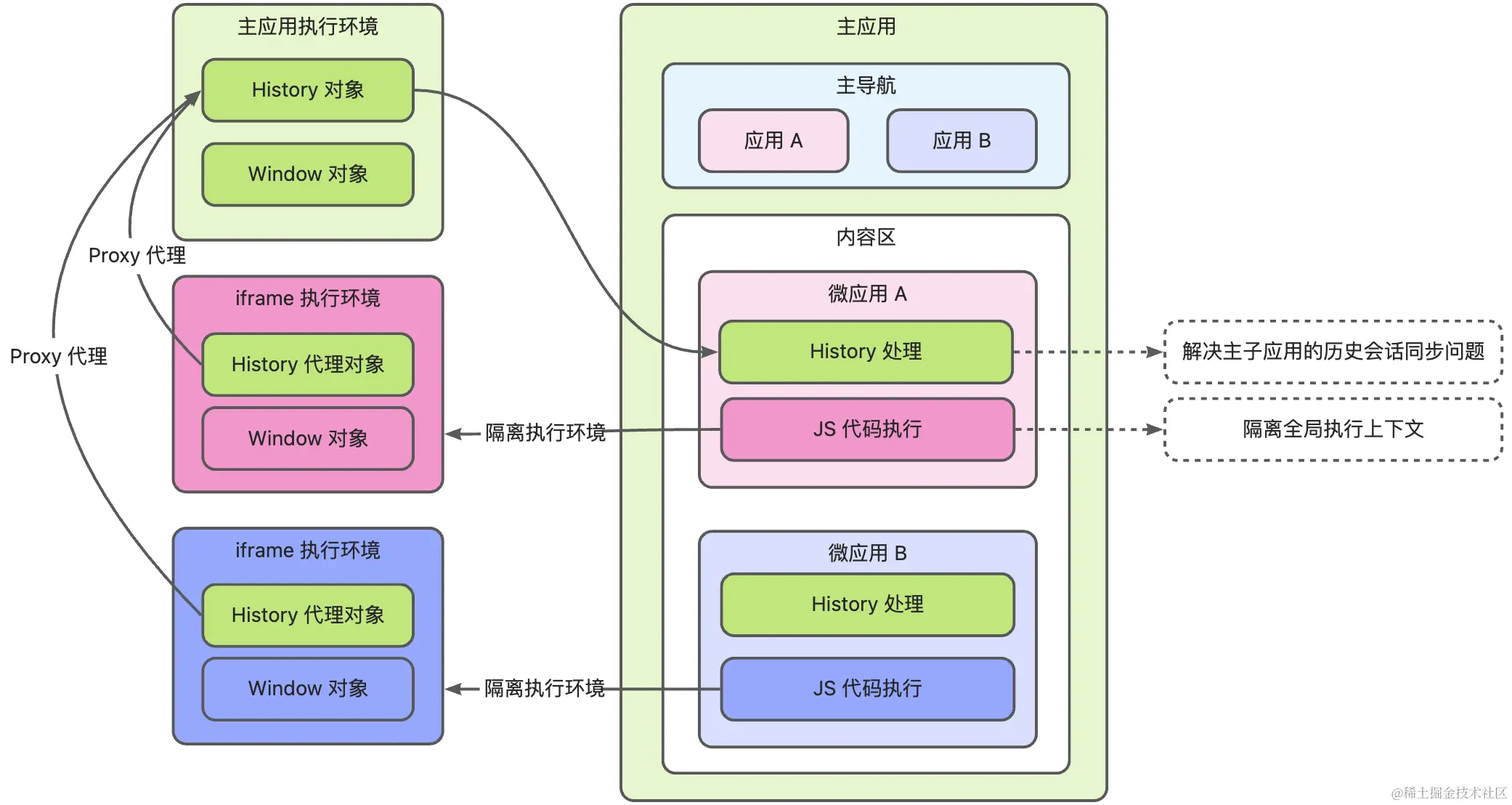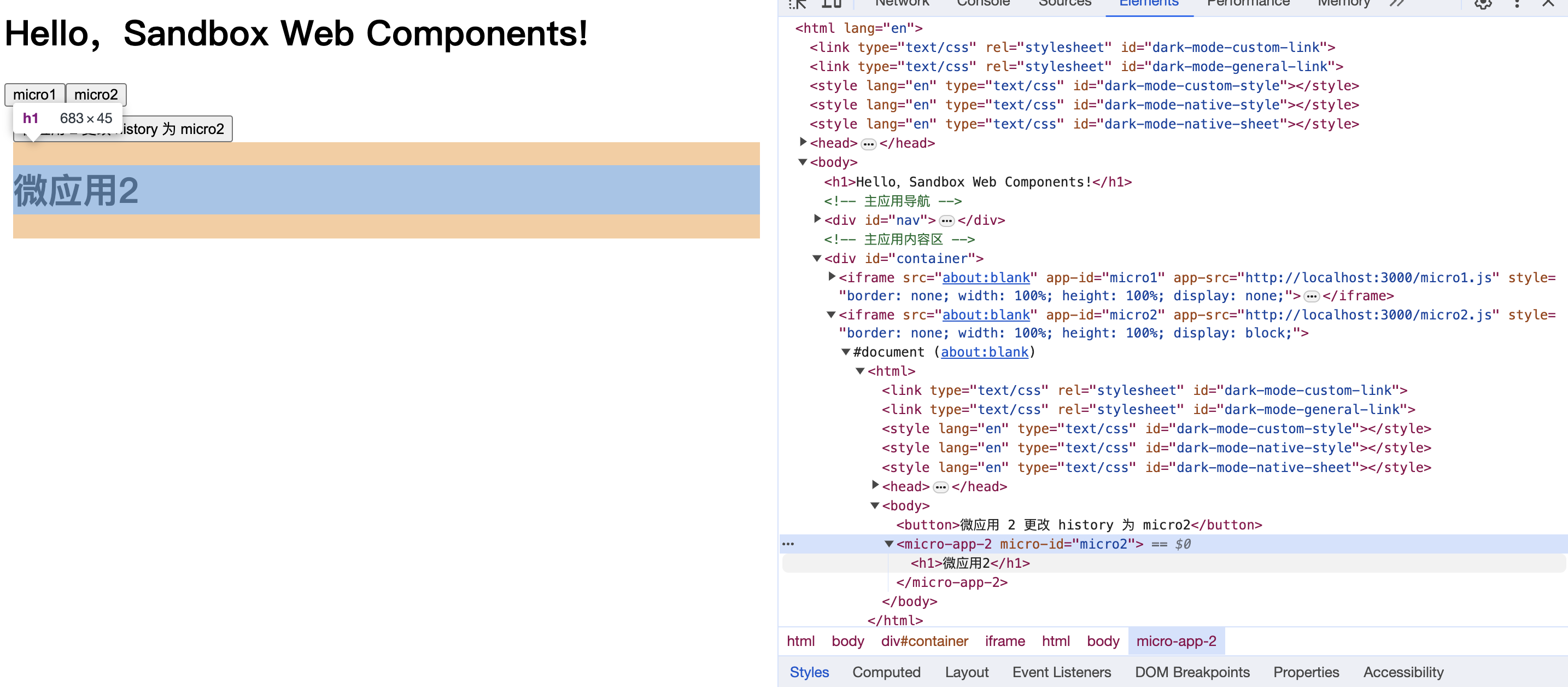MontoApp(五) - js 沙箱:Web Components 与 iframe隔离
本节开始,介绍微前端中 js 隔离的方案。
1. iframe沙箱原理
iframe 之所以支持 js 隔离,是因为在 V8 引擎里,每一个 iframe 都相当于开了一个新的 Isolate 对象,所以就相当于间接使用了 V8 隔离,他们是不同的 V8 上下文。
本文结合之前的 Web Components 加载方案和 iframe 天然沙箱,来实现一个隔离的方案。使用 iframe 的最主要的问题如下:
- 主子路由不统一
- 弹出层不会自动居中
- 数据状态同步问题
我们这里先解决第一个问题,将主应用的 history 对象代理一下传递给子应用:

仓库地址:sandbox/web-components-proxy 分支
我们实现的步骤如下:
- 改造子应用入口,声明自己的定制元素信息
- 主应用启动时,获取子应用信息
- 创建 iframe 元素
- iframe中子应用挂载时,将主应用的 window 代理后传递给子应用
- 子应用开始渲染,执行自己的 js,并挂载自己的定制化元素
- 子应用卸载时,设置 display 为 none 即可,js 不用删除
改造子应用
// 测试代码:全局变量的污染情况
this.a = 'a';
console.log('微应用1 a: ', a);
var b = 'b';
console.log('微应用1 b: ', window.b);
window.c = 'c';
console.log('微应用1 c: ', window.c);
let root = document.createElement("button");
root.textContent = "微应用 1 更改 history 为 micro1";
document.body.appendChild(root);
root.onclick = () => {
// 这里来说明 history 用的是主应用来的代理
history.pushState({}, '', '/micro1');
}
// end:测试代码
class MicroApp1Element extends HTMLElement {
constructor() {
super();
}
connectedCallback() {
console.log(`[micro-app-1]:执行 connectedCallback 生命周期回调函数`);
this.mount();
}
disconnectedCallback() {
console.log(`[micro-app-1]:执行 disconnectedCallback 生命周期回调函数`);
// 卸载处理
this.unmount();
}
// [生命周期回调函数] 当 custom element 增加. 删除. 修改自身属性时,被调用
attributeChangedCallback(attr, oldVal, newVal) {
console.log(
`[app:${this.name}]:执行 attributeChangedCallback 生命周期回调函数`
);
if (this[attr] !== newVal) {
this[attr] = newVal;
this.isConnected && this.mount();
}
}
mount() {
const $micro = document.createElement("h1");
$micro.textContent = "微应用1";
// 将微应用的内容挂载到当前自定义元素下
this.appendChild($micro);
}
unmount() {}
}
window.customElements.define("micro-app-1", MicroApp1Element);
在子应用里定义了 Web Components 的元素声明,其操作的 document 等对象,都是相对于自己的 iframe 内部而言的。
主应用配置子应用列表信息
首先启动服务器:
<!-- 主应用导航 -->
<div id="nav"></div>
<!-- 主应用内容区 -->
<div id="container"></div>
app.use(express.static(path.join("public", "main")));
// ...
app.listen(port.main, host);
配置请求接口(子应用各自的node服务需要配置跨域,这里略去):
app.post("/microapps", function (req, res) {
res.json([
{
name: "micro1",
id: "micro1",
// 自定义元素名称
customElement: "micro-app-1",
// 这里暂时以一个入口文件为示例
script: `http://${host}:${port.micro}/micro1.js`,
style: `http://${host}:${port.micro}/micro1.css`,
prefetch: true,
},
{
name: "micro2",
id: "micro2",
customElement: "micro-app-2",
script: `http://${host}:${port.micro}/micro2.js`,
style: `http://${host}:${port.micro}/micro2.css`,
prefetch: true,
},
]);
});
创建 iframe
我们声明一个 IframeSandbox 类:
// IframeSandbox
constructor(options) {
this.options = options;
// 创建 iframe 时浏览器会创建新的全局执行上下文,用于隔离主应用的全局执行上下文
this.iframe = this.createIframe();
this.iframeWindow = this.iframe.contentWindow;
// 执行 history 代理
this.proxyIframeWindow();
}
在子应用激活时可以这么写:
new IframeSandbox({
rootElm: this.rootElm, // 挂载应用的根节点,这里是 #container
scriptText: this.scriptText,
url: this.app.script,
id: this.app.id,
customElement: this.app.customElement
});
在 IframeSandbox 类里,我们开始构造一个局部的 js sandbox。
首先,使用 src = about:blank 的 iframe 可以保证其与主应用同源:
// IframeSandbox
createIframe() {
const { rootElm, id, url } = this.options;
const iframe = window.document.createElement("iframe");
const attrs = {
src: "about:blank",
"app-id": id,
"app-src": url,
style: "border:none;width:100%;height:100%;",
};
Object.keys(attrs).forEach((name) => {
iframe.setAttribute(name, attrs[name]);
});
rootElm?.appendChild(iframe);
return iframe;
}
app-src 是一种安全策略,指定了只有子应用自己的 url 的资源可以被加载
做 history 代理
由于 history 是在 window 下的,document 也是在 window 下的,我们干脆直接代理主应用的 window 对象:
// IframeSandbox,在主应用中执行的
proxyIframeWindow() {
this.iframeWindow.proxy = new Proxy(this.iframeWindow, {
get: (target, prop) => {
// 只是简单的代理,主子应用路由冲突没有解决
// 思考:为了防止 URL 冲突问题,是否也可以形成设计规范,比如主应用采用 History 路由,子应用采用 Hash 路由,从而确保主子应用的路由不会产生冲突的问题
if (prop === "history" || prop === "location" || prop === "document") {
// 使用主应用 window
return window[prop];
}
if (prop === "window" || prop === "self") {
return this.iframeWindow.proxy;
}
// prop 是修正过的指向
return this.getTargetValue(target, prop);
},
set: (target, prop, value) => {
target[prop] = value;
return true;
},
has: (target, prop) => !!target[prop],
});
}
此时,原生的一些 API 会有问题,比如 window.alert 内部的 this 不是指向 iframe 的 window,而是指向被代理后的 proxy,因此在调用 alert 等原生函数会报错 Illegal invocation。 同类型的方法还有很多,比如 addEventListener. atob 等。
这里的 getTargetValue,用于重新将这些原生 native api 的 this 修正为 iframe 的 window。
我们来看一下实现:
getTargetValue(target, prop) {
const value = target[prop];
// 过滤出 window.alert. window.addEventListener 等 API
if (
typeof value === "function" &&
!this.isBoundedFunction(value) && // 是直接定义的 function,不是 bind 的函数,因为 如果函数已经进行了 bind,那么不应该进行再次的绑定操作
!this.isConstructable(value) // 过滤掉构造函数:例如原生的 Object. Array 以及用户自己创建的构造函数等。一些构造函数不需要进行 bind 操作,因为 bind 生成的函数会失去原有函数的属性和 prototype
) {
console.log('修正 this: ', prop);
// 修正 value 的 this 指向为 target
const boundValue = Function.prototype.bind.call(value, target);
// 重新恢复 value 在 bound 之前的属性和原型(bind 之后会丢失)
for (const key in value) {
boundValue[key] = value[key];
}
// 如果原来的函数存在 prototype 属性,而 bound 之后丢失了,那么重新设置回来
if (
value.hasOwnProperty("prototype") &&
!boundValue.hasOwnProperty("prototype")
) {
boundValue.prototype = value.prototye;
}
return boundValue;
}
return value;
}
其中两个判断函数如下:
isBoundedFunction(fn) {
return (
// 在ES6及之后的版本中,每个函数都有一个 name 属性, 如果函数是通过 function 关键字定义的,那么它的 name 属性值就是这个函数名。但如果函数是通过其他方式(例如使用 Function 构造函数或 Function.prototype.bind 方法)创建的,那么它的 name 属性值可能会被修改或添加前缀 (比如 bound)
// 例子:
/**
let obj = {
x: 10,
getX: function() {
return this.x;
}
};
let getXBoundToObj = obj.getX.bind(obj);
console.log(getXBoundToObj.name); // 输出 bound getX
*/
// 被绑定的函数本身没有 prototype
fn.name.indexOf("bound ") === 0 && !fn.hasOwnProperty("prototype")
);
}
isConstructable(fn) {
// 可以识别 Object. Array 等原生构造函数,也可以识别用户自己创建的构造函数
return (
fn.prototype &&
// 通常情况下构造函数和类的 prototype.constructor 指向本身
fn.prototype.constructor === fn &&
// 通常情况下构造函数和类都会存在 prototype.constructor,因此长度大于等於 1
// 需要注意普通函数中也会存在 prototype.constructor,
// 因此如果 prototype上 有自定义属性或者方法,那么可以判定为类或者构造函数,因此这里的判断是大于 1
// 自建函数,比如function Person {}; ,原型链上没有方法的 class 识别. function Person() {} 识别等,其长度 = 1
// 注意不要使用 Object.keys 进行判断,Object.keys 无法获取 Object.defineProperty 定义的属性
(Object.getOwnPropertyNames(fn.prototype).length > 1
|| (Object.getOwnPropertyNames(fn.prototype).length === 1 && Object.getOwnPropertyNames(fn.prototype)[0] === 'constructor'))
);
// TODO: 没有 constructor 的构造函数识别
// 例如 Person.prototype = {}; 此时没有 prototype.constructor 属性
}
激活与失活函数
接下来在sandbox中定义一下激活子应用的函数:
// IframeSandbox
async active() {
this.iframe.style.display = "block";
// 如果已经通过 Script 加载并执行过 JS,则无需重新加载处理
if (this.execScriptFlag) return;
this.execScript();
this.mount();
this.execScriptFlag = true;
}
其中核心的执行代码和挂载函数如下:
execScript() {
const scriptElement =
this.iframeWindow.document.createElement("script");
// 使用匿名执行是为了保证js作用域不会外泄,并且便于使用代理
scriptElement.textContent = `
(function(window) {
with(window) {
${this.options.scriptText}
}
}).bind(window.proxy)(window.proxy);
`;
this.iframeWindow.document.head.appendChild(scriptElement);
}
mount() {
if (!this.$webcomponent) {
const $slot = this.iframeWindow.document.body;
// 创建组件元素
this.$webcomponent = this.iframeWindow.document.createElement(
this.options.customElement
);
this.$webcomponent.setAttribute("micro-id", this.options.id);
$slot.appendChild(this.$webcomponent);
}
}
上面的函数中,with 语句用于将形参window的所有属性和方法添加到自己的作用域中,其设计的本意用于缩短查找作用域链。
失活比较简单:
inactive() {
this.iframe.style.display = "none";
}
此外还有沙箱本身的销毁函数,这里也提一下:
// IframeSandbox 销毁沙箱
destroy() {
this.options = null;
this.exec = false;
if (this.iframe) {
this.iframe.parentNode?.removeChild(this.iframe);
}
this.iframe = null;
}
到这里,沙箱的设计基本完成!
接下来我们按照加载顺序,首先初始化主应用,获取微应用列表:
async init() {
this.microApps = await this.fetchMicroApps();
this.createNav();
this.navClickListener();
this.hashChangeListener();
// 创建微前端管理实例
this.microManager = new MicroManager(
document.getElementById("container"),
this.microApps
);
}
// 从主应用服务器获请求微应用列表信息
async fetchMicroApps() {
try {
const res = await window.fetch("/microapps", {
method: "post",
});
return await res.json();
} catch (err) {
console.error(err);
}
}
...
// 创建 nav 导航的代码不是核心,略去
// hash 路由变化的监听事件
hashChangeListener() {
// 监听 Hash 路由的变化,切换微应用(这里设定一个时刻只能切换一个微应用)
window.addEventListener("hashchange", () => {
this.microApps?.forEach(async ({ id }) => {
id === window.location.hash.replace("#", "")
? this.microManager.activeApp(id)
: this.microManager.inactiveApp(id);
});
});
}
上面代码提到一个 MicroManager 类,用于管理微前端应用的激活和销毁:
appsMap = new Map();
// 放入全部的微应用到一个map
setAppMaps(apps) {
apps.forEach((app) => {
this.appsMap.set(app.id, new MicroAppManager(this.rootElm, app));
});
}
// 激活微应用
activeApp(id) {
const current = this.appsMap.get(id);
current && current.active();
}
// 失活微应用
inactiveApp(id) {
const current = this.appsMap.get(id);
current && current.inactive();
}
为了便于理解,上面又单独封装了一个 MicroAppManager 类,用于直接操作沙箱:
// 获取 JS 文本(微应用服务需要支持跨域请求)
async fetchScript(src) {
try {
const res = await window.fetch(src);
return await res.text();
} catch (err) {
console.error(err);
}
}
// 激活
async active() {
// 缓存资源处理
if (!this.scriptText) {
this.scriptText = await this.fetchScript(this.app.script);
}
// 如果没有创建沙箱,则实时创建
// 需要注意只给激活的微应用创建 iframe 沙箱,因为创建 iframe 会产生内存损耗
if (!this.sandbox) {
this.sandbox = new IframeSandbox({
rootElm: this.rootElm,
scriptText: this.scriptText,
url: this.app.script,
id: this.app.id,
customElement: this.app.customElement
});
}
this.sandbox.active();
}
// 失活
inactive() {
this.sandbox?.inactive();
}
2. demo 测试
